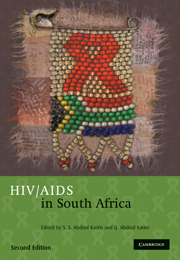Book contents
- Frontmatter
- Contents
- List of Contributors
- Foreword: Peter Piot
- Foreword: Nelson R Mandela
- Acknowledgements
- Section 1 Birth of a rapidly growing epidemic
- Section 2 The virus, the human host and their interactions
- Section 3 HIV risk factors and prevention strategiess
- 9 Reducing sexual risk behaviours: theory and research, successes and challenges
- 10 Barrier methods
- 11 Mother-to-child transmission (MTCT) of HIV-1
- 12 Sexually transmitted infections
- 13 Safe blood supplies
- 14 Intravenous drug use in South Africa
- 15 Positive prevention interventions
- 16 New prevention strategies under development and investigation
- Section 4 Focal groups for understanding the HIV epidemic
- Section 5 The impact of AIDS
- Section 6 Treating HIV
- Section 7 What does the future hold?
- Index
13 - Safe blood supplies
Published online by Cambridge University Press: 07 September 2011
- Frontmatter
- Contents
- List of Contributors
- Foreword: Peter Piot
- Foreword: Nelson R Mandela
- Acknowledgements
- Section 1 Birth of a rapidly growing epidemic
- Section 2 The virus, the human host and their interactions
- Section 3 HIV risk factors and prevention strategiess
- 9 Reducing sexual risk behaviours: theory and research, successes and challenges
- 10 Barrier methods
- 11 Mother-to-child transmission (MTCT) of HIV-1
- 12 Sexually transmitted infections
- 13 Safe blood supplies
- 14 Intravenous drug use in South Africa
- 15 Positive prevention interventions
- 16 New prevention strategies under development and investigation
- Section 4 Focal groups for understanding the HIV epidemic
- Section 5 The impact of AIDS
- Section 6 Treating HIV
- Section 7 What does the future hold?
- Index
Summary
SOUTH AFRICA HAS A blood service based on voluntary non-remunerated donors who have an HIV prevalence much lower than the general population. The Department of Health has delegated responsibility to autonomous, non-profit blood transfusion services and there will be a single blood transfusion service formed under the National Health Act.
The greatest risk of hiv infection from transfused blood arises from the window period of infectivity, although this has been significantly reduced by more sensitive hiv assays (Chapter 6). However, the quality and safety of the blood supply ultimately depends on the donor population and their education is a key component in the provision of safe blood.
The policies and procedures in place to ensure a safe blood supply in South Africa have been successful and depend on actively selecting donors who are at low risk of infection with hiv or other infections transmitted by transfusion.
An effective blood transfusion service is an essential component of a successful health care system. South Africa is fortunate that it has a model blood service based on voluntary non-remunerated blood donors with an hiv prevalence much lower than that of the general population. The devastating impact that hiv/aids may have on blood safety is highlighted by the infection of haemophiliacs in the 1980s, before the cause of the disease was recognised and before blood donations were routinely screened for the presence of hiv antibodies.
- Type
- Chapter
- Information
- HIV/AIDS in South Africa , pp. 226 - 239Publisher: Cambridge University PressPrint publication year: 2010



